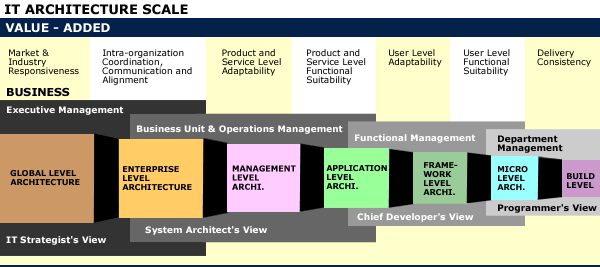| Lesson 9 | IT scale and perspectives |
| Objective | Describe the IT architecture scale. |
IT Scale and Perspectives
The challenge with architecture in e-engineering is dividing the problem space and creating a reference model that is flexible enough to support optimal partitioning for most business domains.
IT Architecture Scale
The IT scale represents natural partitions and perspectives of the architectural effort, moving from external, environmental concerns of the CEO (the global level) to internal, operational concerns of the programmer ( the build level).
As architectural artifacts are developed to support each level, they address finer and finer details of the architectural structures they describe. The surrounding frames indicate the audience (top of box) and the generator/producer (bottom) of the architecture artifacts for the levels contained within the frame.
As architectural artifacts are developed to support each level, they address finer and finer details of the architectural structures they describe. The surrounding frames indicate the audience (top of box) and the generator/producer (bottom) of the architecture artifacts for the levels contained within the frame.
| Value Added | ||||||
| Market and Industry Responsiveness | Intra-Organization Coordination, Communication and Alignment | Product and Service Level Adaptability | Product and Service Level Functional Stability | User Level Adaptability | User Level Functional Stability | Deliver Consistency |

- Global Level Architecture
- Enterprise Level Architecture
- Management Level Architecture
- Application Level Architecture
- Framewok Level Architecture
- Micro Level Architecture
- Build Level Architecture
- Global Level Architecture: Ensure enterprise coordination and collaboration impact of business processes that cross enterprise boundaries between trading partners .
Question: What are their drivers to obtain participation? This level addresses the CEO's concerns regarding improving connectivity and opening new channels in the marketplace.
Example: Extranet decisions on security access protocols for the Inter-enterprise communication key issue impact of business processes that crosses enterprise boundaries. - Enterprise level: Intra-enterprise coordination and collaboration: A single span of control for cross departmental solutions.
Question: How to improve collaboration and knowledge sharing across departments.
The CEO's concerns regarding the internal operations of the enterprise are addressed. At this level, for example ERP common systems decisions, middleware standards, common email or messaging platform.
Key issue: coordination of system level decisions to allow graceful transitions - Management level: Management of integration and complexity within the enterprise focus on adaptability and flexibility in the solution portfolio of applications data an infrastructure example gateways and compatibility decisions network management tools key issue managing integration complexity of business processes applications data and infrastructure
- Application level: Mitigation of performance overhead suitability of functionality point solutions and the degree of satisfaction to the Business Journal requirements performance stability quality example user administration tools logs and reports key issue migrating performance overhead
- Framework level: Reconfiguration strategies leveraging micro architecture to provide user level adaptability example development frameworks such as CORBA EJB standards Key issue: development of reconfiguration strategies leveraging one or more micro architectures.
- Micro level: programmer view of grouping of component usability isolation of lower level components to support modification and extension examples class libraries Sessions beans key issue isolation of lower level solution components to handle future changes.
- Build level: Programmer's view of definition of solution components for customization and delivery consistency examples programming languages and compilers key issue definition and management of lower level solution components
The development of a new framework for architecture must take into consideration that architecture is now a major factor in the success or failure of an Internet-based business venture and therefore must be communicable to a broad range of stakeholders, not just the IT department.
The IT architecture scale reconciles the classic IT (BIT) architecture approach as it evolved from the initial Zachman and James Martin frameworks with the concepts of perspectives and domains.
As discussed earlier, perspectives are segments on the scale axis and these segments partition the scope of issues and concerns of the major stakeholders.
As discussed earlier, perspectives are segments on the scale axis and these segments partition the scope of issues and concerns of the major stakeholders.